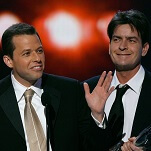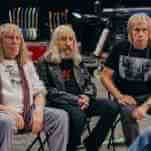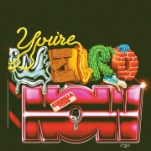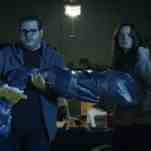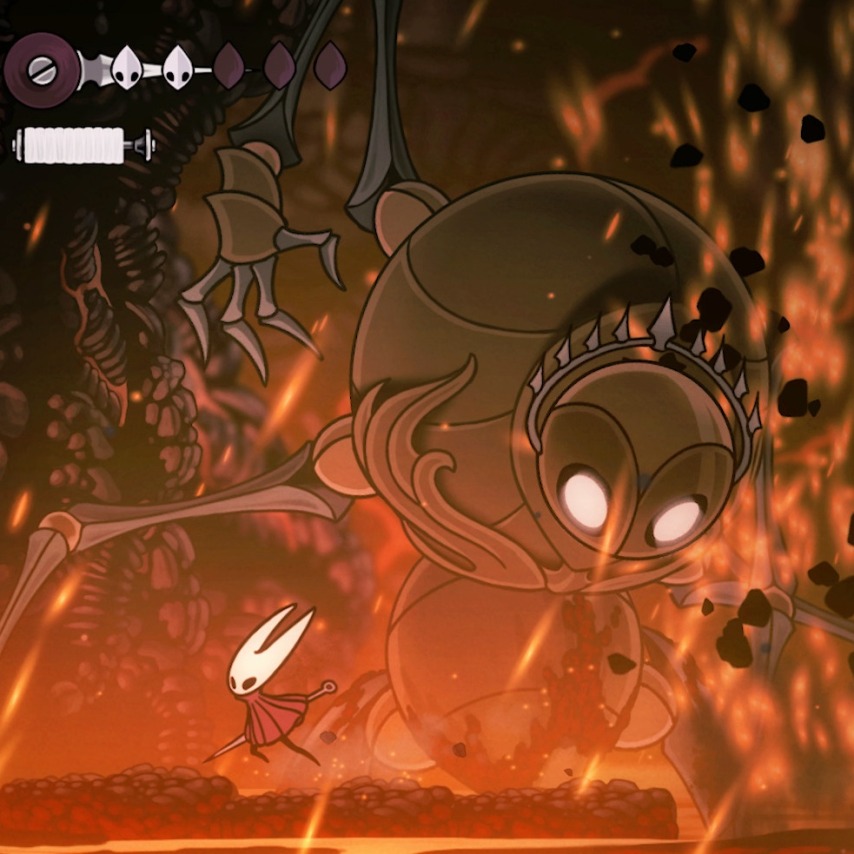Grindcore made its first splash outside its insular bubble with Napalm Death’s 1987 debut, Scum, which includes the one-and-a-fraction-second song “You Suffer,” a favorite of iconic BBC DJ John Peel. The terse, brutal cuts on Scum set the tone for decades of extreme metal to come, and tense opener “Multinational Corporations” lays out grindcore’s moral compass and lyrical blueprint. As spindly, unsettling guitars and chattering cymbals rise to a crest, growling vocalist Nik Bullen repeats the phrase “Multinational corporations / Genocide of the starving nations.”
Grindcore’s anti-capitalist credo cracked open the world to skewer everything, including Christmas, which has become more diametrically opposed to the genre’s orthodox impulses as the rampant consumerism epitomized by Black Friday threatens to overshadow the Christmas spirit. The holiday season has been so distorted by the world of commerce, it’s a wonder there isn’t a grindcore sub-genre made up of vile carols. Perhaps that’s why a handful of intrepid extreme-metal fans banded together four years ago to launch a yuletide series called A Grindcore Christmas. At the very least, they’re offering a distinct vision of a holiday that usually finds its musical expression through warm, joyful tones.
Released December 12, 2011, the first Grindcore Christmas compilation tops out at 28 tracks, all of which are extreme, if not exactly grindcore. An outfit called M.O.S.E.S. contributes the longest number, “Capitalist Gift Day,” which is 6 minutes of harsh noise and obscured howls and growls. Clawz and P-Wrecks throw down “Something To Celebrate,” a lumbering, unbalanced hip-hop cut that spikes cold raps about crowds lunging for door-busters with sleigh-bell samples. Some of the grindcore tracks (or those that most exhibit the genre’s hallmarks) find room in the doom and gloom for shots of the misanthropic humor that has long been a boon for the genre. Techno-powernoise artist Unnatural Selection opens “Snowball” with a flip of “Deck The Halls” on which he proclaims, “’Tis the season to feign interest.” In fitting homage to its namesake’s roots, A Grindcore Christmas was released as a free compilation, and it’s still available as part of the growing digital library of independent musical retailer Bandcamp.
Since it launched in 2008, Bandcamp has become a hub for scrappy bedroom-pop artists, GarageBand producers, and retired cult musicians digitally archiving their catalogs. The eagerness with which independent artists and labels flock to the clean, intuitive platform appears equaled by the fans who use it to purchase music or merch. Relying on a pay-what-you-want model, Bandcamp has raked in more than $130 million for artists since its debut, according to its website, including $4 million in the past month alone. (The company pockets 10 to 15 percent of its digital sales revenue.) Those numbers represent significant growth for a site that, according to co-founder Ethan Diamond, passed the $10,000 monthly payout mark just six years ago, when it handed out $12,000 to artists in May 2009.
Big names—or at least, those big in the indie world—have been key to making Bandcamp a profitable entity. In August 2010, ethereal indie king Sufjan Stevens announced his first proper studio release in five years, an EP called All Delighted People, which came out the day he announced it exclusively on Bandcamp; Stevens sold 10,000 copies in three days through the site, and the EP debuted at No. 48 on the Billboard 200. John Beeler, label manager for Asthmatic Kitty (which Stevens co-founded), praised Bandcamp not only because it made streaming and buying the album easy, but because its music player’s shareable interface further enabled the EP to trend on social media. “I don’t think that kind of hubbub would have happened without Bandcamp,” Beeler told the site.
Stevens’ early success with Bandcamp paved the way for other well-known names to upload their material to the site and bring their audiences with them. Four years to the month after Stevens dropped All Delighted People, actor and onetime Mister Heavenly touring bassist Michael Cera quietly released a collection of lo-fi ditties he recorded on GarageBand called True That; Bandcamp remains the only place it’s available to stream or purchase. But even before Cera came along, the site had already established itself in indie-loving enclaves.
It had also garnered a bit of infamy. In April 2013, a collection of material from beloved, enigmatic producer Jai Paul appeared on a Bandcamp URL bearing his name. It was believed to be his debut full-length, though neither Paul nor his label, XL Recordings, said anything about the release, titled Jai Paul. Paul took to his Twitter account a few days later: “Demos on bandcamp were not uploaded by me, this is not my debut album.” Bandcamp removed the leak, but the memory of its release has lingered—as has the URL.
As much as high-profile releases imprint Bandcamp in the minds of those unfamiliar with the platform, it’s tracks and albums by artists far below the mainstream radar that have helped build the site into the impressive business it is today. Along the way, these musicians have corralled fan bases scattered across the globe into online communities. Every release includes a “supported by” section resting beneath its album cover, and the miniature Bandcamp fan profile pictures that appear within that column are a small manifestation of the people who are drawn to certain acts. These fan images help provide a musician with a more visible base that would otherwise be easy to obscure, or more likely, not notice.
These fans can also give the acts they adore a signal boost. Doom outfit Bongripper, for example, occupied a nice position near the top of Bandcamp’s Chicago chart with 2014’s Miserable, which more than 11,000 people downloaded through the site in less than a year. And after Gainesville, Florida’s Dikembe made its debut EP, 2011’s Chicago Bowls, a pay-what-you-want release through Bandcamp, the emo group ran out of its 200 free download credits in three days; it was a clear sign anticipating the rising interest in the young, underground emo scene that would go on to push its way onto the Billboard charts just a couple of years later.
Even if most releases it houses don’t catch on with a wide audience initially, Bandcamp lets musicians archive their work on the site until people notice. Before releasing Teens Of Style through Matador in October, young indie rocker Will Toledo uploaded 11 full-lengths to Bandcamp under the name Car Seat Headrest—some of which are still available for whatever fee you wish to pay, while the “supported by” columns are filled with photos and messages from those who chipped in. Bandcamp is also where you can find Characters, a 2012 album by an ambitious New Zealand indie outfit called And They Were Masked. It features a powerful singer named Ella Yelich O’Connor, who’d soon become a pop sensation as Lorde.
Then there are the untold number of artists who have helped Bandcamp attain its cultural clout and financial successes while barely disturbing their own bubbles. Bandcamp benefits the more its catalog grows, and even the tiniest contributor stands to gain something simply by showing up. The four volumes of A Grindcore Christmas aren’t dominating Bandcamp’s charts like Michael Cera did when True That made the news, but they’ve helped make the grindcore Bandcamp tag respectably visible by adding weight to the mass of releases filed under the genre’s umbrella. On the site’s imperfect tag list—which seems to organize genres based on which are most used by musicians on the site and includes plenty of repeats the further you scroll down—the first “grindcore” tag appears above less abrasive and more popular genres such as country, psychedelic rock, and grunge.
The first volume of A Grindcore Christmas found a place within its namesake genre largely because of the people behind it. Several web-based microlabels helped out with the compilation, including the peerless Grindcore Karaoke. Founded by scene stalwart and Agoraphobic Nosebleed vocalist J. Randall in 2011, Grindcore Karaoke put out and hosted more than 300 releases in its first two years, including A Grindcore Christmas. Randall released everything for free, covering the costs of additional free download credits by selling T-shirts, and by late 2012, Grindcore Karaoke releases were downloaded more than 5,000 times a week. A Grindcore Christmas contributed to the label’s booming growth (although it’s since stalled out), coming less than four months after Grindcore Karaoke’s biggest release to date, Exmilitary, the debut mixtape by rap lightning rods Death Grips.
The first two Grindcore Christmas compilations are also available for free through the internet archive, but all four releases have a welcome home on Bandcamp. The description on the series’ Bandcamp home page reads “The album that changed Christmas… forever.” The vise grip of mass culture on the holiday season hasn’t shifted much since A Grindcore Christmas debuted, but those with a dour view of the yuletide season may find solace in these compilations. At the very least, they can easily find the compilations on Bandcamp.
